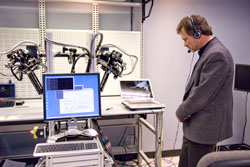New protocol enables interoperability among telesurgical systems

The growth in teleoperation systems has achieved a critical mass that has led researchers to explore ways to collaborate, share facilities and access each others' telerobotic devices.
Nine research teams from universities and research institutes around the world recently collaborated on the first successful demonstration of multiple biomedical robots operated from different locations in the U.S., Europe, and Asia.

Credit: SRI International
The international consortium used a new software protocol called the Interoperable Telesurgical Protocol (ITP). According to a paper- Breaking the Interoperability Barrier Through Emerging Standards- detailing the research, until now,? systems? that allow for the operation of robots over a distance have? used? their? own? ad?hoc? methods? for? network teleoperation.? The new protocol is fully open and meant for sharing. It was cooperatively developed by the University of Washington and SRI International, a non-profit that operated its M7 surgical robot for this demonstration.
In a 24-hour period the research team billed "Plugfest 2009," each participating group connected over the Internet and controlled robots at different locations. According to a news item, "The tests performed demonstrated how a wide variety of robot and controller designs can seamlessly interoperate, allowing researchers to work together easily and more efficiently. In addition, the demonstration evaluated the feasibility of robotic manipulation from multiple sites, and was conducted to measure time and performance for evaluating laparoscopic surgical skills."
"Although many telemanipulation systems have common features, there is currently no accepted protocol for connecting these systems," said SRI’s Tom Low. "We hope this new protocol serves as a starting point for the discussion and development of a robust and practical Internet-type standard that supports the interoperability of future robotic systems."
Professor Blake Hannaford of the University of Washington added, "We're very pleased with the success of the event in which almost all of the possible connections between operator stations and remote robots were successful. We were particularly excited that novel elements such as a simulated robot and an exoskeleton controller worked smoothly with the other remote manipulation systems."
The simplicity of the protocol had much to do with the team's success. It was designed to make cooperation as efficient as possible and connect established heterogeneous systems. They used a "low overhead" binary UDP packet structure that is statically described in a C/C++ header file. During the event, that protocol allowed for any master station at any of the participants labs to connect to and effectively teleoperate any of the slave robots.
They also limited their scope to exclude bilateral teleoperation, saying that it would require significantly more complex software and poses greater risk to the underlying hardware due to instability. Bilateral teleoperation is continuous, uninterrupted feedback (billions of bytes of data) between the robot and operator.
The researchers hope that their findings "will allow engineers and designers that usually develop technologies independently, to work collaboratively, determine which designs work best, encourage widespread adoption of the new communications protocol, and help robotics research to evolve more rapidly."
The demonstration included the following organizations:
- SRI International, Menlo Park, Calif., USA
- University of Washington Biorobotics Lab (BRL), Seattle, Washington, USA
- University of California at Santa Cruz (UCSC), Bionics Lab, Santa Cruz, Calif., USA
- iMedSim, Interactive Medical Simulation Laboratory, Rensselaer Polytechnic Institute, Troy, New York, USA
- Korea University of Technology (KUT) BioRobotics Lab, Cheonan, South Chungcheong, South Korea
- Imperial College London (ICL), London, England
- Johns Hopkins University (JHU), Baltimore, Maryland, USA
- Technische Universität München (TUM), Munich, Germany
- Tokyo Institute of Technology (TOK), Tokyo, Japan